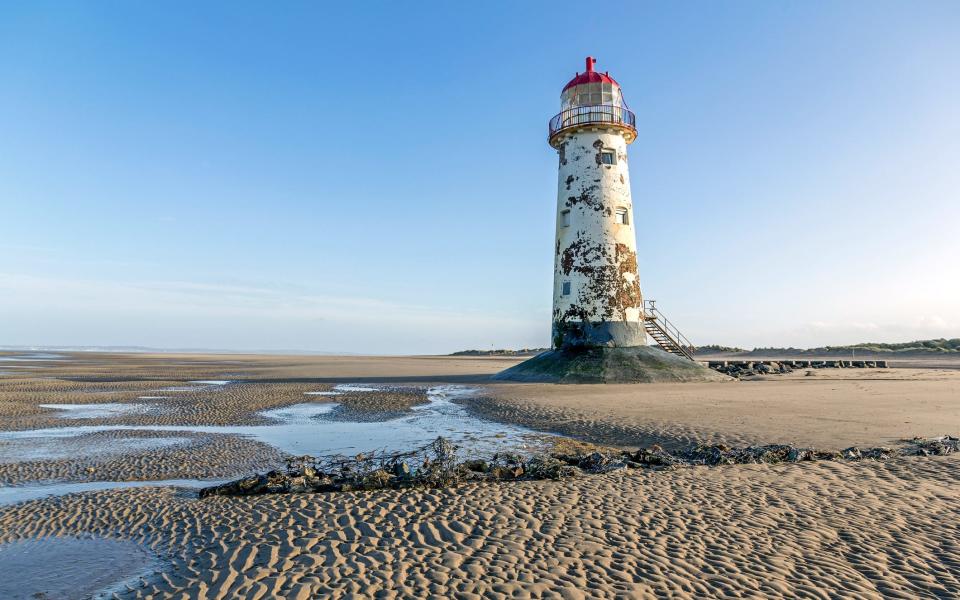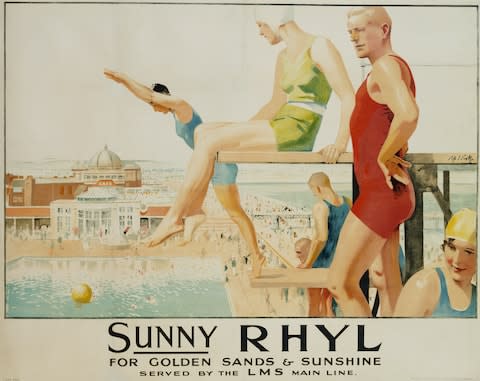Can 'rough around the edges' Rhyl ever bring back the glory days?

My memory of childhood holidays spent in Rhyl - back when flights to Europe weren't cheaper than a train ticket from London - has been gathering dust for two decades now.
In it, I’m ten, with my nose pressed against the glass of a 2p-machine in Les Harker’s amusement arcade, eyes on the treasure trove of coppers that pile up inside. The jarring, eight-bit melody and blinking pink and yellow bulbs both assault my senses and intensify my concentration. I bide my time and then, with a perfectly-timed drop, my coin nudges another off the top shelf, then another below, until, triumph! A waterfall of money. Sixteen pence, to be precise, and all it took was my mum’s investment of £5. To a child who had never seen the sea before moving from Pakistan to the UK a few years prior, this place was paradise.
Standing in the same arcade almost 20 years later, there are fewer wide-eyed children scuttling around but 76-year-old owner Les Harker is still as sprightly as ever.
"If anything’s going through the doldrums it’s seaside towns," he tells me, pulling up a chair from an unmanned coin pusher machine. "But Rhyl has charisma. I would reckon 90 per cent of the people who come here, come again." Not today, judging by the turnout. But October is hardly high-season, when the town’s population of 25,000 doubles and families pack every B&B, hotel and luxury caravan from here to Prestatyn. But are the busy summers enough to carry the town’s quiet seasons? Questionable.
It wasn’t just the increasing availability of cheap package holidays that hit Rhyl. Another roadblock on the path back to its Victorian glory days came in December 2013, when the worst storms in 25 years ravaged the coast and forced 400 homes to be evacuated.

Repairs were carried out and business did improve, for the county of Denbigshire at least, which last year welcomed 5.9 million tourists and £490million last year. But of Rhyl specifically, Harker tells me: "We’re down on this year. We just haven’t had the right kind of weather and families have been heading to the city instead.”
Case in point: as my travel companion and I boarded an overcrowded train from Euston the night prior, I was cheered by the atmosphere - the hiss of Calsbergs being opened, the chatting between old friends, and the chorus of Wonderwall that at one point had me swaying contentedly.
But then we reached Prestatyn, and with murmurings of ‘scuse me love’ and ‘pardon lad’, most of our fellow passengers got off. Prestatyn is arguably a more handsome town, with the twin appeal of having both Roman ancestry and a Topshop, but it’s no Rhyl, my inner child scoffs. Their loss.
We weren't looking for a quiet evening, so the Karaoke music that eminated from the Bodfor Pub, a few minutes walk from the station, seemed like a good bet. From the bar, we observed as a portly woman with a half-sleeve of tattoos handed the microphone to an older gentleman sporting a neat trilby, one who proceeded to serenade us with Frank Sinatra’s New York. To the horror of my companion - who is London-raised and doesn’t talk to strangers - I insisted we join the four San Miguel-swilling men in the dim corner for a game of pool.

They couldn’t have been more welcoming - and I’m sure any of the patrons that night would have been too. After a lengthy bonding session, we headed to our B&B for another hearty welcome. The Roseview, a stone-bricked guesthouse blanketed in autumnal red trees and hidden behind a ring of tall trees, couldn’t have been more Rhyl. The propierenter treated us to a lengthy midnight tour complete with a demonstration on how to run a bath, and expressed his disappointment when we slept through breakfast the next morning. It was charming and perplexing in equal measure.
We made our way down to the seafront to the merry tune of church bells ringing out from St Thomas, a 143-year-old clock tower that watches over the town’s otherwise new and boxy developments. The long stretch of beach was delightfully quiet, but for the dogs bounding happily through the waves, and the sky - a textured symphony of grey and taupe - was, as usual, threatening rain.
I can quite see how this stretch of nothingness was so beloved by British painter David Cox, a grossly unheralded pre-impressionist who spent a lot of time rendering this wind-whipped scene.
Turn around these days, however, and you’re faced with a less romantic view: the £23million waterfront development, still under construction. Government money was in part used to refurbish the Pavilion Theatre, a geometric monolith of overlapping cubes, its facade a deeper grey than the rainclouds over the Irish Sea; along with the new 1891 Restaurant, which sells itself on its fresh, locally-sourced food but that sadly didn’t live up to expectations in terms of the bland polenta we were served.

Across the road sits a large unfinished Premier Inn, and the just-opened pub, Sun Verge, where we met with Tony Vitti, a worldly traveller and hobby historian who runs Rhyl’s tourist office. Some time ago, he returned home from his adventures in the Gambia after a military coup broke out, and seems very happy to have done so.
"There’s a thing about Rhyl people," he says. "When they move away, they always come back. This town was built to welcome people." He’s not wrong. Rhyl was once nothing more than a collection of fishing villages dotted disparately around marshland on the northernmost tip of Wales, until the rise of the Industrial Revolution, when it transformed itself into a popular seaside getaway for the Victorian working class of Manchester and Liverpool.
Later, during the First World War, it flung open its arms to an influx of Belgian refugees fleeing the German invasion. Of the 250,000 who came to the UK, Rhyl took in 66, and thousands of locals lined the streets to welcome them as heroes when they arrived. Prestatyn, on the other hand, wanted a "higher class of migrant", Vitti says.

Rhyl’s heyday was during the Fifties and Sixties, by which time rail travel had made getting there easy. "We still get a huge number of people who come here now, particularly in the caravan parks during the summer, because their parents did,” says Viti, who hasn’t got a bad word to say about Rhyl except that it can be “a bit a brain drain”.
We wrapped up our visit with the aforementioned pit stop at Harker’s arcade - having wandered past a barren aquarium and through deathly quiet streets where betting shops, cafes and pebble-dashed B&Bs share the promenade with derelict, boarded up outlets.
Somehow, and somewhat surprisingly, it's the arcades that appear to have best survived - whether tourists are here or not. There was only one of them in 1966, when Harker, a former fairground worker, and his wife pooled their life savings to buy the space. Now, amusement centres including Bright Spot, Mr B’s, Queens Bowling Centre, Parker Leisure and the Palace jostle for position on the same strip.
"It’s survival of the fittest,” Harker remarked. “The promenades are holding their own. In this business, if you stop, you die.’
As his son Craig called out Bingo numbers over the loudspeaker (sessions of which run throughout the day), Harker let me in on a secret.
"I’ll walk around with £20-worth of change in my pocket," he told me, scanning the room. “If someone’s playing the two-pence-machines, I’ll give them a pound and tell them, “here ya go love, on the house”. I know if I give them that, they’re not going to walk out with it. But next time their kid comes past, I guarantee they’ll want to come in.”
In many ways, Harker perfectly embodies this time-lost town. It’s not fancy, but it doesn’t try to be. It’s rough around the edges, but inherently likeable. It's content with a population of residents that never want to leave, or did once, but came back. It's not doing so well anymore, but it remains determined.
I will always remember Rhyl as the place where I won my treasure, and where people here called me ‘lad’ for the first time since I’d arrived on British soil. Both then and now, I feel welcome, and I’ll be back.
More on Britain's faded seaside towns
The timewarp town that escaped the UK seaside's downward spiral
It's always sunny in Bognor Regis: a postcard from the Sussex Riveria
A nostalgic weekend in Bournemouth, Britain's beach-hut capital
Which town would you like to see featured next? Comment in the box below...

